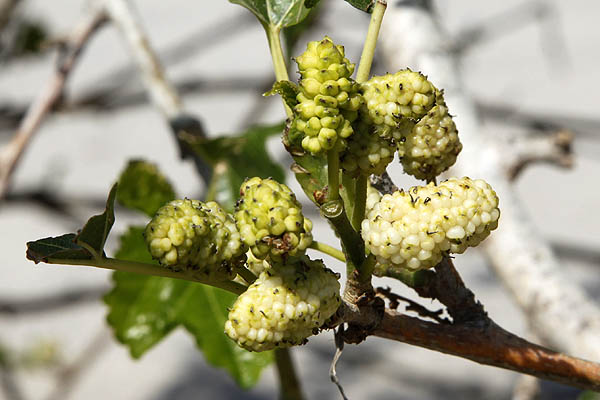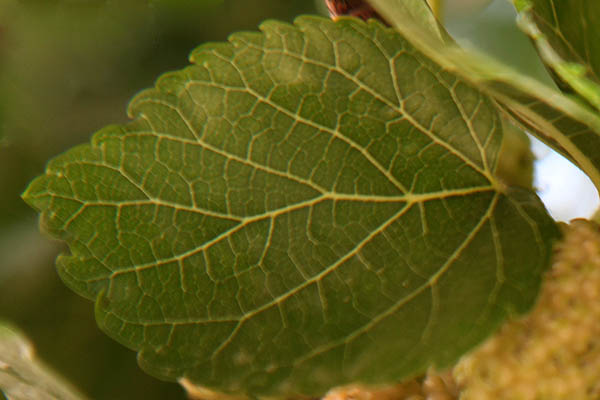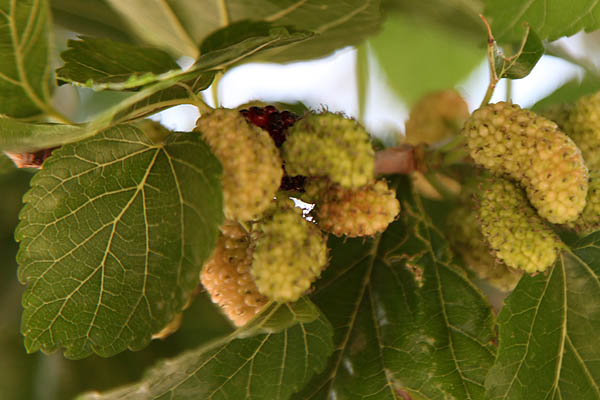
Derivation of the botanical name:
Morus, the Latin name for mulberry.
nigra, black.
Sycamine-tree; Latin sycomorus, Greek συκόμορος sukomoros, “fig-mulberry”, from σῦκον (sukon, “fig”) + μόρον (moron, “mulberry”). Possibly influenced by Hebrew שִׁקמָה (shiqmah, “mulberry”).
The translation of shiqmah is sycamore(-fig), mulberry is tut in Hebrew.
Mulberry from Latin morum + berry, Old English mōrberie.
The Heberew name: תות, tut , from Aramaic תותא / ܬܘܬܐ (tūṯā).
- The standard author abbreviation L. is used to indicate Carl Linnaeus (1707 – 1778), a Swedish botanist, physician, and zoologist, the father of modern taxonomy.
The black mulberry, compared to the white mulberry: is later to flush in spring, holds its leaves later in fall, has thicker leaves on shorter stalks, is bisexual, is notably hairy, has more milky sap, is only a small tree, invariably has black berries, is less cold-hardy, and its berries taste better to most people.
See the list of Medicinal herbs in Israel, the parts used and their medical uses to treat various diseases.
In the Mediterranean countries the white and the black mulberry have been cultivated.
The black mulberry, possibly a derative of the white mulberry, grows wild in Northern Iran, on the shores of the Caspian Sea, and in Colchis, an ancient region on the Black Sea south of the Caucasus Mountains (Colchis is where Jason, the legendary leader of Argonauts, traveled in search of the Golden Fleece ( the winged ram Chrysomallos)). Both species, the white and black mulberry, contain in every part a milky juice, which will coagulate into a sort of Indian rubber, and this has been thought to give tenacity to the filament spun by the silkworm.
- Pliny speaks of its employment in medicine and also describes its use in Egypt and Cyprus. He further relates:
'Of all the cultivated trees, the Mulberry is the last that buds, which it never does until the cold weather is past, and it is therefore called the wisest of trees. But when it begins to put forth buds, it dispatches the business in one night, and that with so much force, that their breaking forth may be evidently heard.'
It has been suggested that the generic name of the Mulberry, Morus, has been derived from the Latin word mora (delay), from this tardy expansion of the buds, and as the wisest of its fellows, the tree was dedicated by the Ancients to Minerva, goddess of wisdom.
- Ovid (43 BCE - 17CE), in Metamorphoses, tells the story of the star-crossed lovers Pyramus and Thisbe, who killed themselves beneath a fruiting white mulberry. When the dying Thisbe prayed to the gods that the tree would "always have fruit of a dark and mournful hue, to make men remember the blood we two have shed," the gods granted her wish and changed the white mulberry into the black mulberry, which stains the hands a reddish color,
- At the time of Virgil (70 - 19 BCE) silk was held to be a product of the Mulberry leaves, the work of the silkworms not being understood. Silkworm culture was first introduced by Justinian I, "Justinian the Great" (483-565 CE), Byzantine emperor.
In Italy the Black Mulberry was employed for feeding the silkworm until about 1434, when Morus alba was introduced from the Levant, the eastern part of the Mediterranean, and has ever since been commonly preferred.
- In 1608 James I (1566-1625), being anxious to promote the silk industry by introducing the culture of the silkworm into Britain, issued an edict encouraging the cultivation of Mulberry trees, but the attempt to rear silkworms in England proved unsuccessful, apparently because the Black Mulberry was cultivated in error, whereas the White Mulberry is the species on which the silkworm flourishes.
- Charlemagne, Charles the Great (742 - 814CE), king of the Franks, enjoyed the trees in his private garden, planted circa 812.
- John Gerard (1545 – 1611/12), an English botanist: "The leaves are broad and sharp pointed, something hard, and nicked on the edges; in stead of flowers are blowings or catkins, which are downy. The fruit is long, made up of a number of little grains, like unto a black-Berry, but thicker, longer, and much greater.
- H.B.Tristram(1822 - 1906) writes: "Both the white and Black Mulberry trees are common in Palestine, and their cultivation has, doubtless, increased since the introduction of the silkworm, fed on their leaves, and the rearing of which is the staple industry of the peasantry in the Lebanon.
- Michael Zohary (1898 - 1983), in 'Plants of the Bible': "While the rendition of tut in Maccabees as 'mulberry tree' raises no questions, the words sycamine in Luke and mesukan in Isaiah, though etymologically cognate, can less certainly be identified with the mulberry, Yet mesukan is clearly related to the Sumerian messikanu or sukannu, identified by Thompson (1949) as 'mulberry' and contextually satisfying in the passage from Isaiah; sycamine may have the same origin.
The Mulberry is also grown for rearing silk about many of the villages between Jerusalem and Nablous (Shechem) and often covers the terraced hill-sides…"
Bible resources:
- Isaiah 40:20
He that is too impoverished for such an oblation chooseth a tree that will not rot; he seeketh unto him a skilful workman to set up a graven image, that shall not be moved.
- I Maccabees 6:34
'They showed the elephants the juice of grapes and mulberries, to arouse them for battle'
- Luke 17:5-6
The apostles said to the Lord, “Increase our faith!”
He replied, “If you have faith as small as a mustard seed, you can say to this mulberry tree, ‘Be uprooted and planted in the sea,’ and it will obey you.

|


